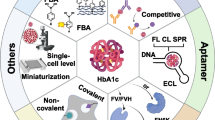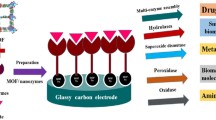Abstract
A novel electrochemical immunosensor for detecting potential depression biomarker Apolipoprotein A4 (Apo-A4) was developed using a multi-signal amplification approach. Firstly, the sensor utilized a modified electrode material, NG-PEI-COF, combining bipyridine-functionalized covalent organic framework (COF) and polyethyleneimine-functionalized nitrogen-doped graphene (NG-PEI), providing high surface area and excellent electron transfer capability for the first-stage amplification in electrical signal conduction. Subsequently, gold nanoparticles (AuNPs) were further electrodeposited onto the electrode, providing good biocompatibility and abundant binding sites for immobilizing the target antigen, thus achieving the second-stage amplification in target recognition and binding. To address the lack of redox properties of the antigen, a tracer probe was formed by loading AuNPs, anti-Apo-A4, and toluidine blue (TB) successively onto COF, leading to the third-stage amplification in signal conversion. The constructed electrochemical immunosensor TB/Ab/AuNPs/COF-Apo-A4/AuNPs/NG-PEI-COF/GCE exhibited excellent detection performance against Apo-A4 with a linear range of 0.01 to 300 ng mL−1 and had a low detection limit of 2.16 pg mL−1 (S/N = 3). In addition, the biosensor had good reproducibility (RSD = 2.31%), stability, and significant anti-interference performance toward other depression biomarkers. The sensor has been successfully used for the quantitative detection of Apo-A4 in serum, providing potential applications for detecting Apo-A4 in the clinic and serving as a reference for constructing sensing methods based on COF.
Graphical Abstract








Similar content being viewed by others
Data availability
The data that support the findings of this study are available from the corresponding author upon reasonable request.
References
Kessler RC, Berglund P, Demler O, Jin R, Merikangas KR, Walters EE (2005) Lifetime prevalence and age-of-onset distributions of DSM-IV disorders in the national comorbidity survey replication. Arch Gen Psychiatry 62:593–602. https://doi.org/10.1001/archpsyc.62.6.593
Shorey S, Ng ED, Wong CHJ (2022) Global prevalence of depression and elevated depressive symptoms among adolescents: a systematic review and meta-analysis. Br J Clin Psychol 61(2):287–305. https://doi.org/10.1111/bjc.12333
USPST Force, Mangione CM, Barry MJ, Nicholson WK, Cabana M, Chelmow D, Coker TR, Davidson KW, Davis EM, Donahue KE, Jaen CR, Kubik M, Li L, Ogedegbe G, Pbert L, Ruiz JM, Silverstein M, Stevermer J, Wong JB (2022) Screening for depression and suicide risk in children and adolescents: US preventive services task force recommendation statement. JAMA 328(15):1534–1542. https://doi.org/10.1001/jama.2022.16946
Harsanyi S, Kupcova I, Danisovic L, Klein M (2022) Selected biomarkers of depression: what are the effects of cytokines and inflammation? Int J Mol Sci 24(1). https://doi.org/10.3390/ijms24010578
Sadeghi M, Roohafza H, Afshar H, Rajabi F, Ramzani M, Shemirani H, Sarafzadeghan N (2011) Relationship between depression and apolipoproteins A and B: a case-control study. Clinics 66(1):113–117. https://doi.org/10.1590/S1807-59322011000100020
Guo QW, Si YJ, Shen YL, Chen X, Yang M, Fang DZ, Lin J (2021) Depression augments plasma APOA4 without changes of plasma lipids and glucose in female adolescents carrying G Allele of APOA4 rs5104. J Mol Neurosci 71(10):2060–2070. https://doi.org/10.1007/s12031-020-01766-7
Kato A, Naitou H, Namioka M, Akimoto M, Ishii T, Sakakibara H, Shimoi K, Nakayama T, Ohashi N (2010) Proteomic identification of serum proteins associated with stress-induced gastric ulcers in fasted rats. Biosci Biotechnol Biochem. 74(4):812–8. https://doi.org/10.1271/bbb.90897
Cheng CW, Chang CC, Chen HW, Lin CY, Chen JS (2018) Serum ApoA4 levels predicted the progression of renal impairment in T2DM. Eur J Clin Invest 48(6):e12937. https://doi.org/10.1111/eci.12937
Jeong DH, Kim HK, Prince AE, Lee DS, Kim YN, Han J, Kim KT (2008) Plasma proteomic analysis of patients with squamous cell carcinoma of the uterine cervix. J Gynecol Oncol 19(3):173–180. https://doi.org/10.3802/jgo.2008.19.3.173
Liao X, Zhang C, Qiu S, Qiu Z, Tang Q, Wu S, Xu J, Wu B, Liu Z, Gao F (2022) Proximity hybridization induced rolling circle amplification for label-free SERS detection of the depression marker human apolipoprotein A4. Talanta 244:123402. https://doi.org/10.1016/j.talanta.2022.123402
Wang Y, Sun B, Wei H, Li Y, Hu F, Du X, Chen J (2022) Investigating immunosensor for determination of depression marker-Apo-A4 based on patterning AuNPs and N-Gr nanomaterials onto ITO-PET flexible electrodes with amplifying signal. Anal Chim Acta 1224:340217. https://doi.org/10.1016/j.aca.2022.340217
Liao X, Zhang C, Liu Z, Gao F (2021) Label-free electrochemical homogeneous detection of the depression marker human apolipoprotein A4 based on proximity hybridization triggered rolling circle amplification. Int J Biol Macromol 183:2305–2313. https://doi.org/10.1016/j.ijbiomac.2021.06.027
Molina A, González J (2016) Pulse voltammetry in physical electrochemistry and electroanalysis. Switzerland: Springer International. https://doi.org/10.1007/978-3-319-21251-7
Bard AJ, Faulkner LR (2001) Electrochemical methods fundamentals and applications. New York: John Wiley & Sons, Inc.
Challhua R, Akashi L, Zuniga J, Beatriz de Carvalho Ruthner Batista H, Moratelli R, Champi A (2023) Portable reduced graphene oxide biosensor for detection of rabies virus in bats using nasopharyngeal swab samples. Biosens Bioelectron 232 115291. https://doi.org/10.1016/j.bios.2023.115291
Yang M, Wang H, Liu P, Cheng J (2021) A 3D electrochemical biosensor based on super-aligned carbon nanotube array for point-of-care uric acid monitoring. Biosens Bioelectron 179:113082. https://doi.org/10.1016/j.bios.2021.113082
Yan X, Su D, Li H, Zhao X, Liu X, Liu F, Sun P, Lu G (2023) Ultrasensitive plasmonic immunosensor based on hierarchically porous metal–organic framework‐engineered enzyme catalysts. Adv Funct Mater 33(21). https://doi.org/10.1002/adfm.202215192
Cote AP, Benin AI, Ockwig NW, O’Keeffe M, Matzger AJ, Yaghi OM (2005) Porous, crystalline, covalent organic frameworks. Science 310(5751):1166–1170. https://doi.org/10.1126/science.1120411
Sun F, Bai L, Li M, Yu C, Liu H, Qiao X, Yan H (2022) Fabrication of edge-curled petals-like covalent organic frameworks and their properties for extracting indole alkaloids from complex biological samples. J Pharm Anal 12(1):96–103. https://doi.org/10.1016/j.jpha.2020.12.006
Ding S-Y, Gao J, Wang Q, Zhang Y, Song W-G, Su C-Y, Wang W (2011) Construction of covalent organic framework for catalysis: Pd/COF-LZU1 in Suzuki-Miyaura coupling reaction. J Am Chem Soc 133(49):19816–19822. https://doi.org/10.1021/ja206846p
Fu Y, Wu Y, Chen S, Zhang W, Zhang Y, Yan T, Yang B, Ma H (2021) Zwitterionic covalent organic frameworks: attractive porous host for gas separation and anhydrous proton conduction. ACS Nano 15(12):19743–19755. https://doi.org/10.1021/acsnano.1c07178
Dong H, Lu M, Wang Y, Tang H-L, Wu D, Sun X, Zhang F-M (2022) Covalently anchoring covalent organic framework on carbon nanotubes for highly efficient electrocatalytic CO2 reduction. Appl Catal B 303. https://doi.org/10.1016/j.apcatb.2021.120897
Zheng J, Zhao H, Ning G, Sun W, Wang L, Liang H, Xu H, He C, Zhao H, Li CP (2021) A novel affinity peptide-antibody sandwich electrochemical biosensor for PSA based on the signal amplification of MnO(2)-functionalized covalent organic framework. Talanta 233:122520. https://doi.org/10.1016/j.talanta.2021.122520
Hosokawa T, Tsuji M, Tsuchida K, Iwase K, Harada T, Nakanishi S, Kamiya K (2021) Metal-doped bipyridine linked covalent organic framework films as a platform for photoelectrocatalysts. J Mater Chem A 9(17):11073–11080. https://doi.org/10.1039/d1ta00396h
Xu X, Zhao R, Ai W, Chen B, Du H, Wu L, Zhang H, Huang W, Yu T (2018) Controllable design of MoS2 nanosheets anchored on nitrogen-doped graphene: toward fast sodium storage by tunable pseudocapacitance. Adv Mater 30(27):1800658. https://doi.org/10.1002/adma.201800658
Wang L, Sun M, Zhu S, Zhang M, Ma Y, Xie D, Li S, Mominou N, Jing C (2021) Cu-Ni bimetallic single atoms supported on TiO2@NG core-shell material for the removal of dibenzothiophene under visible light. Sep Purif Technol 279:119646. https://doi.org/10.1016/j.seppur.2021.119646
Sun B, Li D, Hou X, Li W, Gou Y, Hu F, Li W, Shi X (2020) A novel electrochemical immunosensor for the highly sensitive and selective detection of the depression marker human apolipoprotein A4. Bioelectrochemistry 135:107542. https://doi.org/10.1016/j.bioelechem.2020.107542
Shang Z, Su T, Jin D, Xu Q, Hu X, Shu Y (2023) An integrated and flexible PDMS/Au film-based electrochemical immunosensor via Fe-Co MOF as a signal amplifier for alpha fetoprotein detection. Biosens Bioelectron 230:115245. https://doi.org/10.1016/j.bios.2023.115245
Xiang Z, Jiang C, Yang J, Huang L, Jiang B, Wang X, Gao C, Li M, Meng Y, Tong L, Ling B, Wang Y, Wu J, Chinese consortium for the study of hepatitis (2023) Serum extracellular vesicle-derived ASS1 is a promising predictor for the occurrence of HEV-ALF. J Med Virol 95(1):e28425. https://doi.org/10.1002/jmv.28425
Pei R, Ye L, Jing C (2023) Enzyme-based electrochemical biosensor for antimonite detection in water. Biosens Bioelectron 229:115244. https://doi.org/10.1016/j.bios.2023.115244
Peng X, Zhu J, Wu Z, Wen W, Zhang X, Chen M-M, Wang S (2023) High-efficient Pt@COF nanospheres-based electrochemical-chemical-chemical redox cycling for ultrasensitive microRNAs biosensing. Sens Actuators B Chem 392. https://doi.org/10.1016/j.snb.2023.134074
Zhao H, Zheng J, Liang H, Liu H-F, Liu F, Zhang Y-P, Li C-P (2023) Electrochemical/colorimetric dual-mode sensing strategy for cardiac troponin I detection based on zirconium nitride functionalized covalent organic frameworks. Sens Actuators B Chem 391. https://doi.org/10.1016/j.snb.2023.134026
Guo L, Mu Z, Yan B, Wang J, Zhou J, Bai L (2022) A novel electrochemical biosensor for sensitive detection of non-small cell lung cancer ctDNA using NG-PEI-COFTAPB-TFPB as sensing platform and Fe-MOF for signal enhancement. Sens Actuators B Chem 350. https://doi.org/10.1016/j.snb.2021.130874
Ranjeesh KC, Illathvalappil R, Veer SD, Peter J, Wakchaure VC, Goudappagouda KV, Raj S, Kurungot S.S. Babu (2019) Imidazole-linked crystalline two-dimensional polymer with ultrahigh proton-conductivity. J. Am. Chem. Soc. 141(38):14950–14954. https://doi.org/10.1021/jacs.9b06080
Ma TQ, Kapustin EA, Yin SX, Liang L, Zhou ZY, Niu J, Li LH, Wang YY, Su J, Li J, Wang XG, Wang WD, Wang W, Sun JL, Yaghi OM (2018) Single-crystal x-ray diffraction structures of covalent organic frameworks. Science 361(6397):48–52. https://doi.org/10.1126/science.aat7679
Wei W, Zhou S, Ma DD, Li Q, Ran M, Li X, Wu XT, Zhu QL (2023) Ultrathin conductive bithiazole-based covalent organic framework nanosheets for highly efficient electrochemical biosensing. Adv Funct Mater. https://doi.org/10.1002/adfm.202302917
Zhou D, Kang Z, Liu X, Yan W, Cai H, Xu J, Zhang D (2023) High sensitivity ammonia QCM sensor based on ZnO nanoflower assisted cellulose acetate-polyaniline composite nanofibers. Sens Actuators B Chem 392. https://doi.org/10.1016/j.snb.2023.134072
Ren Y, Rao R, Bhusal S, Varshney V, Kedziora G, Wheeler R, Kang Y, Roy A, Nepal D (2020) Hierarchical assembly of gold nanoparticles on graphene nanoplatelets by spontaneous reduction: implications for smart composites and biosensing. ACS Applied Nano Materials 3(9):8753–8762. https://doi.org/10.1021/acsanm.0c01555
Xu L, Wang F, Ge X, Liu R, Xu M, Yang J (2019) Covalent organic frameworks on reduced graphene oxide with enhanced electrochemical performance. Microporous Mesoporous Mater 287:65–70. https://doi.org/10.1016/j.micromeso.2019.05.054
Funding
This work was supported by the National Natural Science Foundation of China (81972018), the major science and technology project of Gansu Province (21ZD4FA013), the Gansu Province People's Livelihood Science and Technology Special Project – Rural Revitalization Special Project (22CX2NK004), the Central Government Guiding Local Science and Technology Development Fund Project (22ZY1QA012), the Special Project of Science and Technology Commissioner of Gansu Province (22CX8GA009), and the Talent Innovation and Entrepreneurship Project of Lanzhou (2017-RC-115, 2020-RC-41).
Author information
Authors and Affiliations
Corresponding authors
Ethics declarations
Conflict of interest
The authors declare no competing interests.
Additional information
Publisher's Note
Springer Nature remains neutral with regard to jurisdictional claims in published maps and institutional affiliations.
Rights and permissions
Springer Nature or its licensor (e.g. a society or other partner) holds exclusive rights to this article under a publishing agreement with the author(s) or other rightsholder(s); author self-archiving of the accepted manuscript version of this article is solely governed by the terms of such publishing agreement and applicable law.
About this article
Cite this article
Chen, Y., Guo, M., Wang, Z. et al. A novel electrochemical immunosensor for sensitive detection of depression marker Apo-A4 based on bipyridine-functionalized covalent organic frameworks. Microchim Acta 191, 179 (2024). https://doi.org/10.1007/s00604-024-06260-0
Received:
Accepted:
Published:
DOI: https://doi.org/10.1007/s00604-024-06260-0




